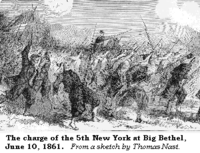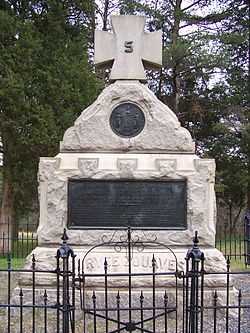5th New York Volunteer Infantry
| 5th Regiment New York Volunteer Infantry | |
|---|---|
|
New York state flag | |
| Active | April 15, 1861 to 1863 |
| Country | United States |
| Allegiance | Union |
| Branch | Infantry |
| Engagements |
Peninsular Campaign Battle of Gaines Mill Battle of Fredricksburg Battle of Chancellorsville |

The 5th New York Volunteer Infantry was a volunteer infantry regiment that fought during the American Civil War, led by Colonel Abram Duryée. It is also known as the "Duryée's Zouaves," named after their colorful Zouave uniforms. Their uniform was modeled after the French Zouaves of Crimean War fame. The 5th New York's uniform was a close representation of the French Zouave uniform in color and style which some Union and Confederate infantry regiments adopted. The uniform consisted of a dark blue Zouave jacket with red trim, a dark blue Zouave vest with red trim, a red Zouave sash with sky blue trim, extremely baggy red pantaloons, a red fez with a yellow tassel, white gaiters and leather jambières. A sister regiment, the 165th New York, known as the Second Battalion Duryee Zouaves, wore the same uniform as the 5th with the exception of the fez's tassel which was dark blue instead of yellow-gold. Photographic evidence suggests that later in the war the 165th was given replacement sashes that were a solid red color without the light blue trim.
Formation
The regiment was formed on April 12, 1861, by a group of military enthusiasts in Manhattan and deployed from Fort Schuyler at Throgs Neck, New York Harbor. Colonel Abram Duryée was appointed as the commander of the regiment. The majority of the soldiers were educated and above average height. On May 24, the regiment boarded a transport to reach the Virginia Peninsula. Immediately at Fort Monroe, the regiment began making scouting expeditions.
By the end of July, the regiment moved to Baltimore, Maryland, where they built and garrisoned an earthen fort at the summit of Federal Hill. Duryée was promoted to general rank, so Gouverneur Kemble Warren took over command of the regiment. There, the regiment continuously drilled, until General George McClellan ordered the regiment to join the Army of the Potomac in the campaign to capture Richmond, Virginia. McClellan said that, upon seeing the colorful New York regiment, "the Fifth is the best disciplined and soldierly regiment in the Army."
Fighting
At the Battle of Hanover Courthouse on May 27, 1862, the regiment played only a minor role. However, they fought in a more major role in the Battle of Gaines' Mill of the Seven Days Battles. As McClellan moved his base to the James River on June 27, 1862, the regiment fought against the Confederate soldiers under Gregg’s South Carolina brigade. In a counterattack, the regiment defeated the initial Rebel attack.
In August 1862, the regiment fell under the control of General John Pope. At the Second Battle of Bull Run (also known as the Second Battle of Manassas), the 5th New York Volunteer Infantry regiment was forced to withstand the advancing forces of General James Longstreet. In underestimating the size of the Confederate army, Pope ordered the regiment to support Hazlett’s Battery. Longstreet’s soldiers easily outnumbered the small regiment, and the Texas Brigade quickly inflicted over 330 casualties in the regiment. One hundred twenty Zouaves were killed within eight minutes, the greatest single battle fatality of all Federal volunteer infantry regiments in the entire Civil War. The entire Color Guard was killed, except for one man. The only officer to survive the battle was Captain Cleveland Winslow.
Later, at the Battle of Antietam, September 17, the unit was held in reserve. On December 15, the unit fought at the Battle of Fredericksburg, covering the Union retreat. At the Battle of Chancellorsville under Joseph Hooker, the unit saw its final combat.
Legacy

Following the conclusion of the war, members of the 5th New York Veterans Association continued to hold monthly meetings. The veterans' association funded the creation of a statue to General Warren, their first commander, on Little Round Top at Gettysburg. They also erected a monument to the regiment at the scene of their greatest sacrifice on the battlefield of Second Bull Run (Manassas). The association was also contributed to a monument to the Army of the Potomac's 5th Corps in Fredericksburg National Cemetery in Virginia.
See also
References
- Zouave. Retrieved April 23, 2006.
External links
- New York State Military Museum and Veterans Research Center - 5th Infantry Regiment - Civil War History, table of battles and casualties, Civil War newspaper clippings, historical sketch, national flag and regimental flag for the 5th New York Infantry Regiment.
- Camp and field life of the Fifth New York Volunteer Infantry: (Duryee Zouaves) (1879) on Internet Archive
.svg.png)